Today in Naval History - Naval / Maritime Events in History
8th of August
some of the events you will find here,
please use the following link where you will find more details and all other events of this day .....
1745 - John Byng promoted to Rear-Admiral of the Blue - The start of his ending career
Byng is best known for "failing" to relieve a besieged British garrison during the Battle of Minorca at the beginning of the Seven Years' War. Byng had sailed for Minorca at the head of a hastily assembled fleet of vessels, some of which were in poor condition. He fought an inconclusive engagement with a French fleet off the Minorca coast, and then elected to return to Gibraltar to repair his ships. Upon return to Britain, Byng was court-martialled and found guilty of failing to "do his utmost" to prevent Minorca falling to the French. He was sentenced to death and, after pleas for clemency were denied, was shot dead by a firing squad on 14 March 1757.
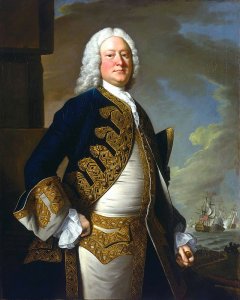
Remark Uwe: It seems to be, that George Byng was a typical "son", but make your own opinion!

The Shooting of Admiral Byng, artist unknown
1796 - HMS Mermaid (1784 – 32 gun Active class Frigate) engaged Vengeance and batteries.
HMS Mermaid was a 32-gun Active-class fifth-rate frigate of the Royal Navy, launched in 1784. During the French Revolutionary Wars she served in the West Indies, the Channel, and the Mediterranean. During the Napoleonic Wars she first served in the Americas, but from early 1811 on, she was armed en flute and served as a troopship until she was broken up in 1815.

1806 - Launch of French 110 gun ship Commerce de Paris
The Commerce de Paris was a 110-gun ship of the line of the French Navy, lead ship of her class.

The Commerce de Paris under construction in Toulon in 1806
1808 - Boats of HMS Porcupine (1807 - 22 guns), Cptn. Hon. Henry Duncan, cut out Conception.
HMS Porcupine was a Royal Navy Banterer-class post ship of 24 guns, launched in 1807. She served extensively and relatively independently in the Adriatic and the Western Mediterranean during the Napoleonic Wars, with her boats performing many cutting out expeditions, one of which earned for her crew the Naval General Service Medal. She was sold for breaking up in 1816 but instead became the mercantile Windsor Castle. She was finally sold for breaking up in 1826 at Mauritius.
After dark on 8 August, Porcupine, still under the command of Duncan, had her cutter and jolly boat under Lieutenant Francis Smith cut out a vessel she had run ashore on the island of Pianosa. The cutting out party was successful, bringing out Concepcion, which was armed with four guns. She had been lying within 30 yards of a tower and a shore battery of six guns. She was also defended by soldiers on the beach and one of her guns which she had landed. She had been carrying bale goods from Genoa to Cyprus. The action cost Porcupine one man killed, and a lieutenant and eight men severely wounded, with three men later dying of their wounds. Smith might have received a promotion for this and prior actions but Duncan's letter to Admiral Collingwood was lost and the duplicate arrived only after Collingwood had died in March 1810.
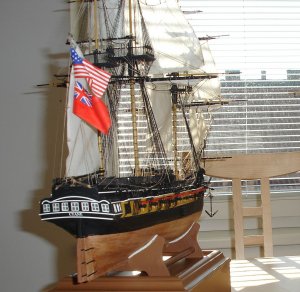
1914 - The Imperial Trans-Antarctic Expedition (1914–17), also known as the Endurance Expedition started from Plymouth
The Edurance Expedition is considered the last major expedition of the Heroic Age of Antarctic Exploration. Conceived by Sir Ernest Shackleton, the expedition was an attempt to make the first land crossing of the Antarctic continent. After the conquest of the South Pole by Roald Amundsen in 1911, this crossing remained, in Shackleton's words, the "one great main object of Antarctic journeyings". The expedition failed to accomplish this objective, but became recognised instead as an epic feat of endurance.

Endurance under full sail by Frank Hurley, paget plate, 1914–1915 State Library New South Wales a090012h
1915 - Beginning of the Battle of the Gulf of Riga
The Battle of the Gulf of Riga was a World War I naval operation of the German High Seas Fleet against the Russian Baltic Fleet in the Gulf of Riga in the Baltic Sea in August 1915. The operation's objective was to destroy the Russian naval forces in the Gulf in preparation for landing German troops to facilitate the fall of Riga in the later stages of the Central Powers' offensive on the Eastern Front in 1915. The German fleet, however, failed to achieve its objective and was forced to return to its bases; Riga remained in Russian hands until it fell to the German Army on 1 September 1917.

Russian Battleship Slawa (1915)
1940 - Launch of japanese battleship Yamato
Yamato (大和) was the lead ship of her class of battleships built for the Imperial Japanese Navy (IJN) shortly before World War II. She and her sister ship, Musashi, were the heaviest and most powerfully armed battleships ever constructed, displacing 72,800 tonnes at full load and armed with nine 46 cm (18.1 in) Type 94 main guns, which were the largest guns ever mounted on a warship.
Named after the ancient Japanese Yamato Province, Yamato was designed to counter the numerically superior battleship fleet of the United States, Japan's main rival in the Pacific. She was laid down in 1937 and formally commissioned a week after the Pearl Harbor attack in late 1941. Throughout 1942, she served as the flagship of the Combined Fleet, and in June 1942 Admiral Isoroku Yamamoto directed the fleet from her bridge during the Battle of Midway, a disastrous defeat for Japan. Musashi took over as the Combined Fleet flagship in early 1943, and Yamato spent the rest of the year, and much of 1944, moving between the major Japanese naval bases of Truk and Kure in response to American threats. Although present at the Battle of the Philippine Sea in June 1944, she played no part in the battle.

1942 - The Battle of Savo Island, also known as the First Battle of Savo Island
and, in Japanese sources, as the First Battle of the Solomon Sea (第一次ソロモン海戦 Dai-ichi-ji Soromon Kaisen), and colloquially among Allied Guadalcanal veterans as The Battle of the Five Sitting Ducks,[4][5] was a naval battle of the Pacific Campaign of World War II between the Imperial Japanese Navy and Allied naval forces. The battle took place on August 8–9, 1942 and was the first major naval engagement of the Guadalcanal campaign, and the first of several naval battles in the straits later named Ironbottom Sound, near the island of Guadalcanal.

The U.S. Navy heavy cruiser USS Quincy (CA-39) photographed from a Japanese cruiser during the Battle of Savo Island, off Guadalcanal, 9 August 1942. Quincy, seen here burning and illuminated by Japanese searchlights, was sunk in this action. The flames at the far left of the picture are probably from the USS Vincennes (CA-44), also on fire from gunfire and torpedo damage.
2000 – Confederate submarine H.L. Hunley is raised
to the surface after 136 years on the ocean floor and 30 years after its discovery by undersea explorer E. Lee Spence.
H. L. Hunley, often referred to as Hunley, was a submarine of the Confederate States of America that played a small part in the American Civil War. Hunley demonstrated the advantages and the dangers of undersea warfare. She was the first combat submarine to sink a warship (USS Housatonic), although Hunley was not completely submerged and, following her successful attack, was lost along with her crew before she could return to base. The Confederacy lost 21 crewmen in three sinkings of Hunley during her short career. She was named for her inventor, Horace Lawson Hunley, shortly after she was taken into government service under the control of the Confederate States Army at Charleston, South Carolina.

8th of August
some of the events you will find here,
please use the following link where you will find more details and all other events of this day .....
Naval/Maritime History - 27th of August - Today in Naval History - Naval / Maritime Events in History
3 August 1918 - hospital ship HMAT Warilda was torpedoed by the German submarine and sunk HMAT Warilda (His Majesty's Australian Transport) was a 7713-ton vessel, built by William Beardmore and Company in Glasgow as the SS Warilda for the Adelaide Steamship Company. She was designed for the...
shipsofscale.com
1745 - John Byng promoted to Rear-Admiral of the Blue - The start of his ending career
Byng is best known for "failing" to relieve a besieged British garrison during the Battle of Minorca at the beginning of the Seven Years' War. Byng had sailed for Minorca at the head of a hastily assembled fleet of vessels, some of which were in poor condition. He fought an inconclusive engagement with a French fleet off the Minorca coast, and then elected to return to Gibraltar to repair his ships. Upon return to Britain, Byng was court-martialled and found guilty of failing to "do his utmost" to prevent Minorca falling to the French. He was sentenced to death and, after pleas for clemency were denied, was shot dead by a firing squad on 14 March 1757.

Remark Uwe: It seems to be, that George Byng was a typical "son", but make your own opinion!
The Shooting of Admiral Byng, artist unknown
1796 - HMS Mermaid (1784 – 32 gun Active class Frigate) engaged Vengeance and batteries.
HMS Mermaid was a 32-gun Active-class fifth-rate frigate of the Royal Navy, launched in 1784. During the French Revolutionary Wars she served in the West Indies, the Channel, and the Mediterranean. During the Napoleonic Wars she first served in the Americas, but from early 1811 on, she was armed en flute and served as a troopship until she was broken up in 1815.
1806 - Launch of French 110 gun ship Commerce de Paris
The Commerce de Paris was a 110-gun ship of the line of the French Navy, lead ship of her class.
The Commerce de Paris under construction in Toulon in 1806
1808 - Boats of HMS Porcupine (1807 - 22 guns), Cptn. Hon. Henry Duncan, cut out Conception.
HMS Porcupine was a Royal Navy Banterer-class post ship of 24 guns, launched in 1807. She served extensively and relatively independently in the Adriatic and the Western Mediterranean during the Napoleonic Wars, with her boats performing many cutting out expeditions, one of which earned for her crew the Naval General Service Medal. She was sold for breaking up in 1816 but instead became the mercantile Windsor Castle. She was finally sold for breaking up in 1826 at Mauritius.
After dark on 8 August, Porcupine, still under the command of Duncan, had her cutter and jolly boat under Lieutenant Francis Smith cut out a vessel she had run ashore on the island of Pianosa. The cutting out party was successful, bringing out Concepcion, which was armed with four guns. She had been lying within 30 yards of a tower and a shore battery of six guns. She was also defended by soldiers on the beach and one of her guns which she had landed. She had been carrying bale goods from Genoa to Cyprus. The action cost Porcupine one man killed, and a lieutenant and eight men severely wounded, with three men later dying of their wounds. Smith might have received a promotion for this and prior actions but Duncan's letter to Admiral Collingwood was lost and the duplicate arrived only after Collingwood had died in March 1810.

1914 - The Imperial Trans-Antarctic Expedition (1914–17), also known as the Endurance Expedition started from Plymouth
The Edurance Expedition is considered the last major expedition of the Heroic Age of Antarctic Exploration. Conceived by Sir Ernest Shackleton, the expedition was an attempt to make the first land crossing of the Antarctic continent. After the conquest of the South Pole by Roald Amundsen in 1911, this crossing remained, in Shackleton's words, the "one great main object of Antarctic journeyings". The expedition failed to accomplish this objective, but became recognised instead as an epic feat of endurance.
Endurance under full sail by Frank Hurley, paget plate, 1914–1915 State Library New South Wales a090012h
1915 - Beginning of the Battle of the Gulf of Riga
The Battle of the Gulf of Riga was a World War I naval operation of the German High Seas Fleet against the Russian Baltic Fleet in the Gulf of Riga in the Baltic Sea in August 1915. The operation's objective was to destroy the Russian naval forces in the Gulf in preparation for landing German troops to facilitate the fall of Riga in the later stages of the Central Powers' offensive on the Eastern Front in 1915. The German fleet, however, failed to achieve its objective and was forced to return to its bases; Riga remained in Russian hands until it fell to the German Army on 1 September 1917.
Russian Battleship Slawa (1915)
1940 - Launch of japanese battleship Yamato
Yamato (大和) was the lead ship of her class of battleships built for the Imperial Japanese Navy (IJN) shortly before World War II. She and her sister ship, Musashi, were the heaviest and most powerfully armed battleships ever constructed, displacing 72,800 tonnes at full load and armed with nine 46 cm (18.1 in) Type 94 main guns, which were the largest guns ever mounted on a warship.
Named after the ancient Japanese Yamato Province, Yamato was designed to counter the numerically superior battleship fleet of the United States, Japan's main rival in the Pacific. She was laid down in 1937 and formally commissioned a week after the Pearl Harbor attack in late 1941. Throughout 1942, she served as the flagship of the Combined Fleet, and in June 1942 Admiral Isoroku Yamamoto directed the fleet from her bridge during the Battle of Midway, a disastrous defeat for Japan. Musashi took over as the Combined Fleet flagship in early 1943, and Yamato spent the rest of the year, and much of 1944, moving between the major Japanese naval bases of Truk and Kure in response to American threats. Although present at the Battle of the Philippine Sea in June 1944, she played no part in the battle.
1942 - The Battle of Savo Island, also known as the First Battle of Savo Island
and, in Japanese sources, as the First Battle of the Solomon Sea (第一次ソロモン海戦 Dai-ichi-ji Soromon Kaisen), and colloquially among Allied Guadalcanal veterans as The Battle of the Five Sitting Ducks,[4][5] was a naval battle of the Pacific Campaign of World War II between the Imperial Japanese Navy and Allied naval forces. The battle took place on August 8–9, 1942 and was the first major naval engagement of the Guadalcanal campaign, and the first of several naval battles in the straits later named Ironbottom Sound, near the island of Guadalcanal.
The U.S. Navy heavy cruiser USS Quincy (CA-39) photographed from a Japanese cruiser during the Battle of Savo Island, off Guadalcanal, 9 August 1942. Quincy, seen here burning and illuminated by Japanese searchlights, was sunk in this action. The flames at the far left of the picture are probably from the USS Vincennes (CA-44), also on fire from gunfire and torpedo damage.
2000 – Confederate submarine H.L. Hunley is raised
to the surface after 136 years on the ocean floor and 30 years after its discovery by undersea explorer E. Lee Spence.
H. L. Hunley, often referred to as Hunley, was a submarine of the Confederate States of America that played a small part in the American Civil War. Hunley demonstrated the advantages and the dangers of undersea warfare. She was the first combat submarine to sink a warship (USS Housatonic), although Hunley was not completely submerged and, following her successful attack, was lost along with her crew before she could return to base. The Confederacy lost 21 crewmen in three sinkings of Hunley during her short career. She was named for her inventor, Horace Lawson Hunley, shortly after she was taken into government service under the control of the Confederate States Army at Charleston, South Carolina.







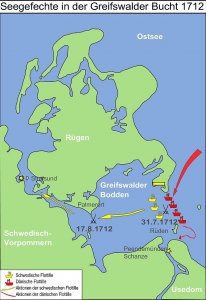
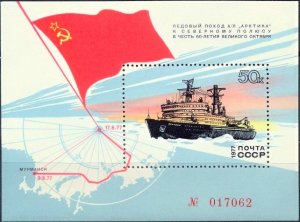
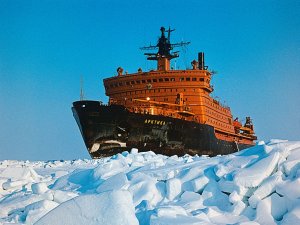


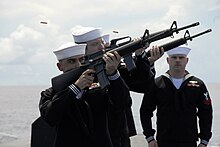
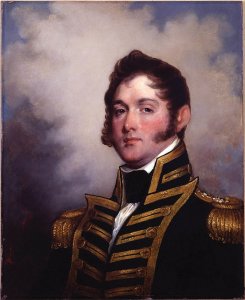
 age (French: Combat naval de Fou-Tchéou, Chinese:
age (French: Combat naval de Fou-Tchéou, Chinese: 